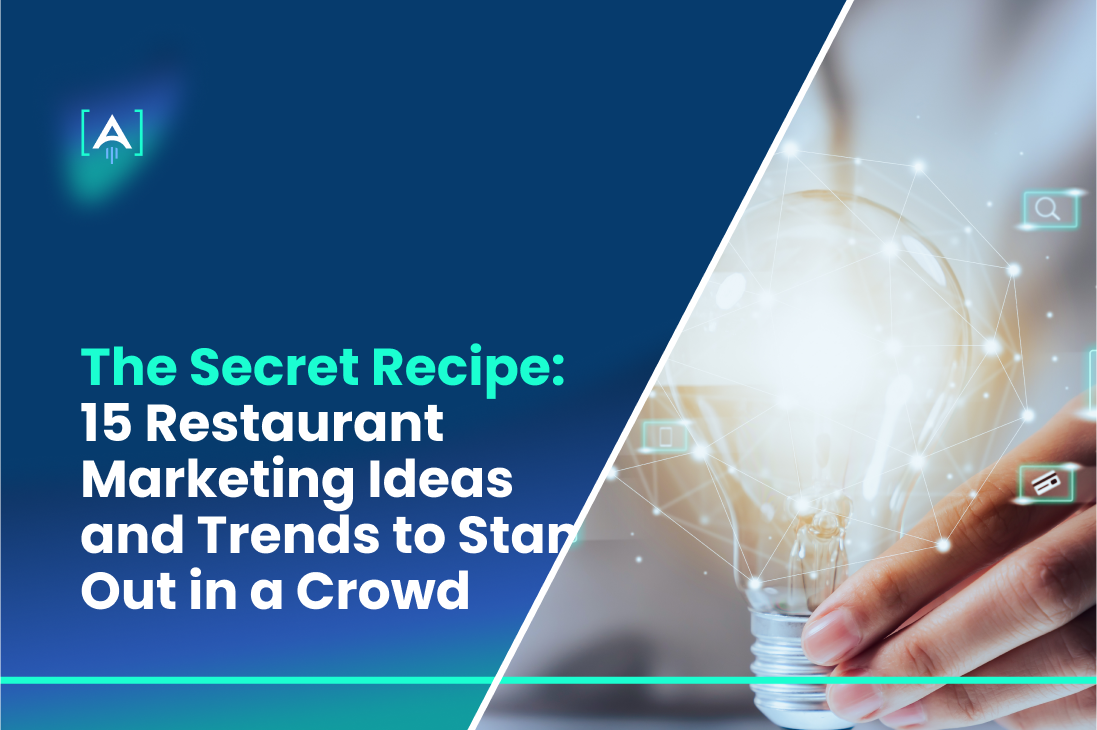Standing out isn’t just about great food. It’s about captivating your audience.
Picture this: a once-quiet neighborhood eatery is now a bustling hotspot.
How did they do it? By embracing the power of digital marketing, creative promotions, and a deep understanding of their customers’ desires.
93% of traffic to websites comes from search engines.
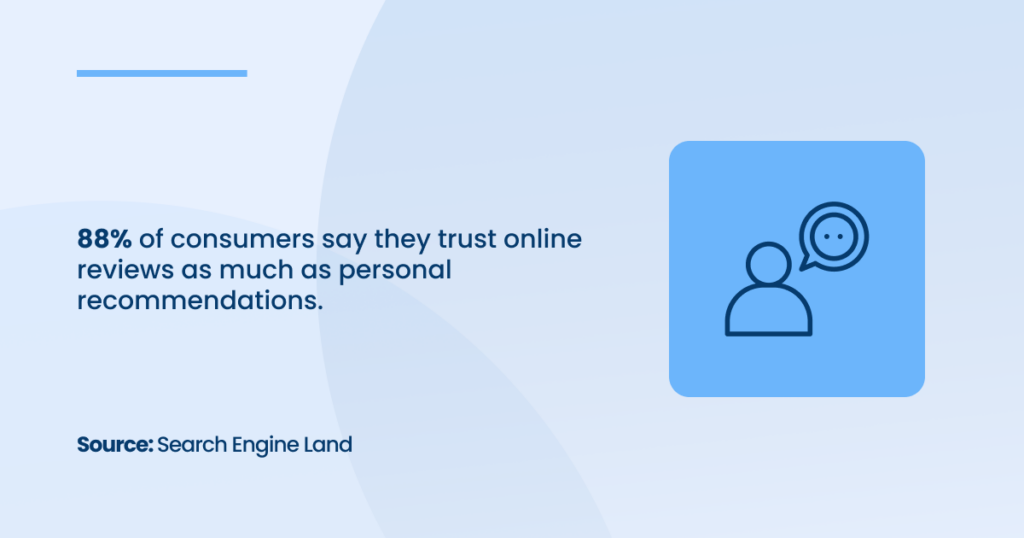
Here comes the solution.
In the age of endless food delivery apps and social media influencers, your restaurant needs more than just a good chef. It needs a marketing mastermind! Well, an expert B2C Marketing Agency will help you master the skills professionally.
In this session, we’ll explore the latest trends and tactics to help you capitalize on this growing opportunity.
1. Beyond the Plate: Why Storytelling Is Your Secret Ingredient
A restaurant isn’t just a place to eat—it’s an experience.
Business owners and CEOs in the hospitality industry know that food alone often isn’t enough to secure long-term growth.
This is where storytelling steps in, weaving an emotional connection between your brand and your customers.
When done well, storytelling elevates your restaurant beyond a transactional visit to a memorable journey.
Stories Humanize Your Brand
People connect with people, not faceless businesses.
Your restaurant’s story—how it began, the inspiration behind your dishes, or the challenges you overcame—turns a business into a relatable entity.
CEOs should remember that a compelling origin story can resonate deeply with customers, sparking curiosity and loyalty.
Pro tip: Share why your restaurant exists. Did you start it to honor your grandmother’s recipes? Was it your dream after years of working in kitchens across the globe? These elements set the stage for a powerful narrative that customers can emotionally invest in.
Build Emotional Engagement Beyond Just Food
Engagement is the bridge to loyalty.
When customers learn that your restaurant sources its ingredients locally to support community farmers or that your kitchen is committed to sustainability, it adds depth to their dining experience.
This strategy taps into trends in restaurant marketing where conscious consumerism is rising.
Why it works:
- Emotional stories foster a sense of belonging. Customers love to feel like they’re part of something bigger.
- Sharing behind-the-scenes content, like staff stories or a day in the life of the chef, strengthens this bond.
AI marketing tip: Use AI-powered tools to personalize how these stories reach your customers. AI can help track customer preferences, ensuring your most engaging stories land with the right audience for higher impact and ROI.
2. The Digital Feast: Mastering Online Ordering and Reservations
In today’s fast-paced world, convenience reigns supreme.
As a business owner or CEO, ensuring your restaurant stays competitive means embracing digital solutions that make the customer experience seamless.
Integrating user-friendly online ordering and reservation systems is not just a modern perk—it’s essential for capturing more business, even beyond your regular operating hours.
Why Streamlining Online Interactions Matters
Customers expect quick, effortless ways to order food and book tables.
Studies show that 54% of diners in the UK won’t consider a restaurant if they can’t book online. This statistic underlines how vital it is to offer a smooth, tech-driven experience.
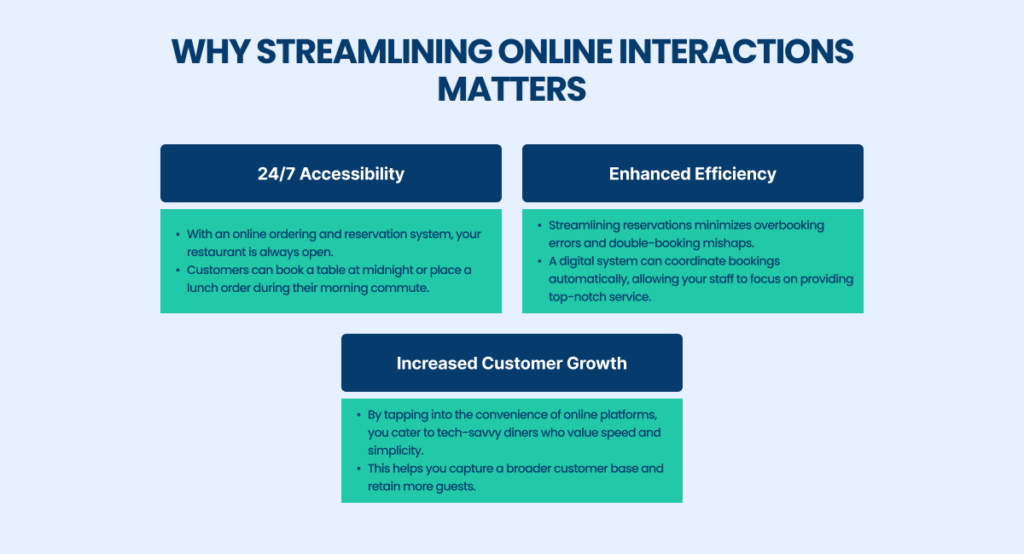
Key Features to Integrate for Maximum Impact
When considering an online ordering and reservation system, look for the following:
- User-Friendly Interface: Ensure your platform is intuitive and easy to navigate. A confusing system can lead to cart abandonment or lost reservations.
- Mobile Compatibility: With most consumers accessing services via smartphones, mobile optimization is a must. Websites or apps that function seamlessly on mobile devices can see a significant boost in engagement and sales.
- Integration with POS Systems: A robust system should sync with your restaurant’s POS to streamline order processing and reduce manual input.
- Customizable Options: Allow customers to customize their meals and add notes for dietary restrictions. Personalization enhances the user experience and shows you value their preferences.
Pro Tip: Offer incentives like “10% off your first online order” to encourage customers to use your new system. This can be a powerful hook to get repeat business.
The Experimentation Roadmap
- Introduce your system in phases
- Start by rolling out online reservations
- Track its ROI
- Measure customer feedback
- Gradually expand to include online ordering.
This step-by-step approach helps identify which features drive the most customer growth, allowing for informed adjustments.
Paid vs. Organic Marketing for Your Digital Launch
Use a combination of paid and organic marketing to promote your new system:
- Paid Ads: Highlight the convenience and ease of booking with targeted ads on Google and social media. Ensure your ads include a strong call-to-action, such as “Reserve your spot today with one click!”
- Organic Content: Share videos on social media demonstrating how to use the system. Post customer testimonials and success stories to create social proof and encourage more users to adopt your digital solutions.
3. AI in Action: Transforming Customer Engagement
Imagine knowing what your customers crave before they even walk through your door.
This might sound like something out of a sci-fi novel, but it’s entirely possible with AI.
Artificial intelligence is revolutionizing restaurant marketing trends, offering unparalleled personalization and operational efficiency.
How AI Personalizes Customer Interactions
AI tools enable restaurants to engage customers in smarter ways. Here’s how:
- Automated Recommendations: AI can analyze past customer behavior to suggest dishes they might enjoy. For instance, if a customer frequently orders seafood, an AI system can highlight a new seafood special during their next visit.
- 24/7 Chatbots: Chatbots are more than just virtual assistants; they’re your frontline customer service agents. They handle reservation inquiries, answer questions, and even provide recommendations around the clock.
- Predictive Analysis: By sifting through data, AI can forecast which menu items will perform best on specific days or times, helping you optimize your offerings and reduce waste.
Growth Marketing Insight
CEOs and business owners should view AI not just as a tech upgrade but as a core element of their growth marketing strategy.
The insights AI provides can lead to a higher ROI by tailoring marketing efforts to what customers want most.
4. From Diners to Marketers: Leveraging User-Generated Content (UGC)
Your customers can be your most powerful marketers.
In the age of social proof, user-generated content (UGC) is a gem for any restaurant looking to bolster trust and credibility.
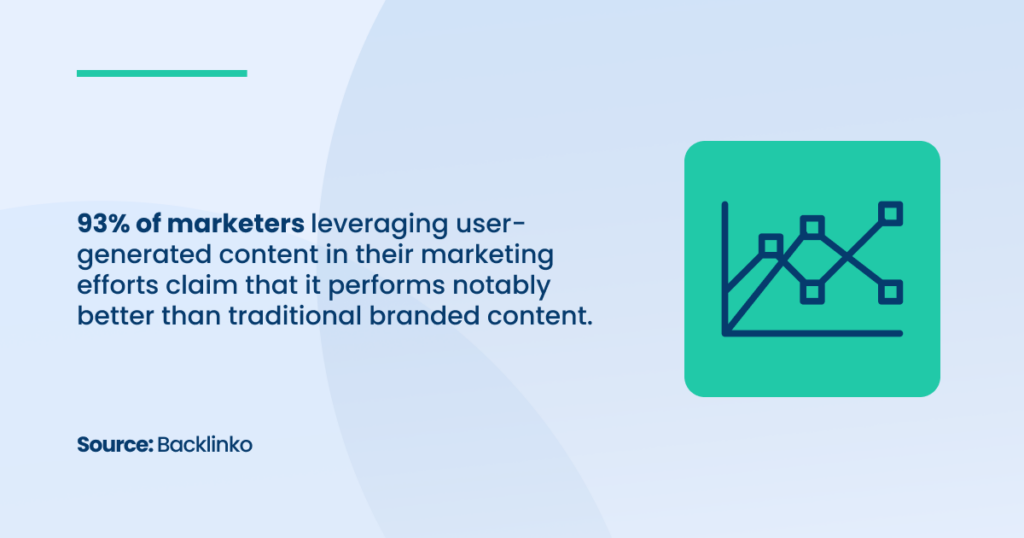
Imagine diners sharing their experiences, highlighting dishes, and posting glowing reviews—all creating an authentic buzz without a single dollar spent on ads.
Why UGC Works Wonders for Restaurants
- Authenticity Drives Engagement: People trust content from other consumers more than they do branded promotions. According to Nielsen, 92% of consumers trust UGC more than traditional advertising.
- Cost-Effective Advertising: Every shared post is essentially free marketing. It amplifies your reach without increasing your marketing budget.
- SEO Benefits: More user-generated content can enhance your online presence, improve SEO, and boost your restaurant’s ranking on search engines.
How to Encourage UGC in Your Restaurant
- Set Up Photo-Worthy Spaces: Create visually appealing corners or table settings that encourage diners to snap and share.
- Offer Incentives: Introduce a “Share Your Experience” campaign where diners can earn a discount or free item when they post about their meal using a specific hashtag.
- Repost and Engage: Actively share UGC on your social media accounts and engage with posts by liking and commenting. This interaction not only builds community but also motivates more customers to share.
- Promote Custom Hashtags: Use a unique, branded hashtag that customers can include in their posts. This can boost visibility and create a pool of easily trackable content.
Tip for CEOs: Implementing an experimentation roadmap for UGC initiatives can help you identify what resonates most with your audience and fine-tune future campaigns.
5. The Power of Personalization: Making Guests Feel Known
Gone are the days of one-size-fits-all dining experiences.
Today’s restaurant marketing trends emphasize personalization as a tool to enhance customer loyalty and drive growth.
Source: McKinsey & Company
How to Implement Personalization in Your Restaurant
- Leverage Customer Data: Use reservation data and loyalty programs to gather insights into customer preferences. This information can be used to tailor special promotions or menu suggestions.
- Customized Promotions: Offer birthday discounts, seasonal menu recommendations, or personalized “Welcome Back” messages to loyal customers.
- Tech Integration: Invest in AI-powered CRM tools that can track customer behavior and preferences. These tools enable automated but personalized interactions—like suggesting a wine pairing based on previous orders.
- Feedback Loops: Encourage guests to leave feedback and make a note of it. Use that data to tailor their future experiences, like preparing a favorite dessert without them having to ask.
Key Point for Business Owners: Investing in innovative marketing strategies that include personalization not only improves the customer journey but also enhances AI ROI by maximizing the relevance of each interaction.
6. The Influencer Edge: Collaborating for Maximum Reach
Think of influencers as modern-day food critics with a digital megaphone.
Partnering with the right influencer can put your restaurant in front of thousands of engaged followers who trust their recommendations.
Source: Influencer marketing market size worldwide from 2016 to 2024, Statista
But not all influencers are created equal, so how do you choose the right one for your brand?
The Benefits of Collaborating with Food Influencers
- Rapid Brand Exposure: An influencer’s post about your restaurant can drive significant traffic, leading to immediate spikes in bookings and orders.
- Targeted Marketing: Choose influencers whose audiences match your target demographics—whether that’s local food lovers, families, or fine dining enthusiasts.
- Content Variety: Influencers create high-quality content, showcasing your restaurant through photos, reels, or stories, saving you the effort of in-house production.
How to Choose the Right Influencer for Your Brand
- Engagement Over Follower Count: Don’t just go for the influencer with the largest following. Micro-influencers (with 1,000-10,000 followers) often have higher engagement rates and more loyal audiences.
- Authenticity is Key: Select influencers who align with your brand’s values and voice. A luxury restaurant might collaborate with a fine dining blogger, while a quirky café may pair with a fun, casual food vlogger.
- Trial Periods: Start with a short-term partnership to test the waters. This allows you to evaluate whether the collaboration aligns with your brand goals and brings tangible customer growth.
Getting Started
- Host Influencer Nights: Invite influencers for exclusive tasting events. This ensures they experience your offerings firsthand and can share authentic reviews.
- Cross-Promotion: Make the most of your collaboration by sharing influencer content on your own channels. This can be part of your paid vs. organic marketing strategy, where paid boosts ensure the content reaches beyond the influencer’s initial post.
7. TikTok and Trends: Riding the Wave of Viral Content
If you’re not on TikTok, you’re missing out on a goldmine of engagement.
This platform, along with Instagram Reels, has transformed the way restaurants approach video marketing.
Source: Exploding Topics
Short, punchy, and highly shareable, these videos have the power to make your dishes—and your brand—go viral.
Why TikTok and Instagram Reels Matter
- Massive User Base: TikTok has over a billion active users, with Gen Z and millennials making up the majority. If your restaurant targets these demographics, TikTok is where you must be.
- Trend Capitalization: Leveraging trending songs, hashtags, or challenges can put your content in front of thousands—even millions—of potential customers.
- Short-Form Engagement: People love bite-sized, entertaining content. A 15-second video of your chef flambéing a dessert or a quick kitchen hack can attract thousands of views.
How to Utilize TikTok and Reels for Your Restaurant
- Behind-the-Scenes Content: Show customers how their favorite dishes are made. “A Day in the Life of Our Chef” or “How We Make Our Signature Dish” are great hooks.
- Participate in Trends: Keep an eye on popular challenges and hashtags. If there’s a “Weird Food Combo” trend, showcase an unexpected but delicious pairing from your menu.
- Interactive Content: Run a poll or a quick Q&A with your chef. This kind of engagement is perfect for creating a personal connection with potential diners.
- Menu Showcases and Challenges: Introduce new menu items or run a fun challenge like “Finish Our Giant Sundae in Under 5 Minutes”. These are eye-catching and often get shared widely.
8. Sustainable Dining: Winning Customers with Eco-Friendly Practices
In today’s world, sustainability isn’t just a buzzword—it’s a business strategy.
Modern diners, especially the environmentally conscious ones, actively seek out restaurants that align with their values. Embracing eco-friendly practices can set your restaurant apart and establish a loyal customer base.
Why Sustainability Matters in Restaurant Marketing
- Consumer Expectations: Studies show that more than 60% of consumers prefer brands that are environmentally conscious. For CEOs and business owners, this means embracing sustainability can directly impact customer growth.
- Brand Differentiation: In a saturated market, eco-friendly practices become an innovative marketing strategy that highlights your restaurant’s commitment to the community and the planet.
- Long-Term Cost Savings: Sustainable practices such as energy-efficient appliances and waste reduction can lead to long-term financial benefits.
Eco-Friendly Practices to Consider
- Sourcing Locally: Highlight your use of local ingredients. Not only does this support nearby farms and producers, but it also reduces the carbon footprint associated with transporting goods. Tip: Share stories about your partnerships with local suppliers to humanize your brand and engage customers emotionally.
- Reducing Waste: Implement food waste management systems and donate leftover food to local charities. Statistics indicate that 30-40% of food supply in the U.S. is wasted, so taking active steps here can resonate with eco-conscious diners.
- Eco-Friendly Packaging: As takeout and delivery continue to be key components of restaurant marketing trends, ensure your packaging is biodegradable or compostable. Showcase this in your digital marketing, emphasizing your efforts to reduce single-use plastics.
Key Strategy for Business Owners: Develop an experimentation roadmap to test and measure the impact of each sustainable initiative. This allows for adjustments and highlights which strategies resonate most with your audience.
9. AR Menus: A Glimpse into the Future of Dining
Imagine a world where diners can visualize their meal before it reaches their table.
Source: Exploding topics
Augmented reality (AR) menus are no longer a futuristic concept; they’re an emerging trend that enhances the dining experience and brings an interactive edge to your restaurant’s offerings.
Why AR Menus Are Transformative
- Reducing Order Hesitation: One common pain point in dining is uncertainty over menu items. AR menus help diners see a 3D representation of dishes, giving them confidence in their choices.
- Enhanced Engagement: AR technology can turn the dining experience into a visual and interactive journey. This unique feature encourages diners to share their experience on social media, effectively acting as organic growth marketing.
- Upselling Opportunities: By visually showcasing premium menu items, restaurants can strategically nudge customers toward higher-priced options.
Implementing AR Menus: A How-To for CEOs
- Partner with Tech Experts: Collaborate with growth marketing agencies that specialize in restaurant tech solutions. There are questions to ask growth agency to ensure the agency understands your brand vision and can tailor the AR experience accordingly.
- Highlight Special Dishes: Use AR to emphasize signature dishes or new items. Let customers preview ingredients, nutritional details, and preparation methods with a simple scan of their phone.
- Collect Feedback: After implementing AR menus, gather customer opinions to tweak and improve the technology. This step helps keep the menu experience fresh and user-friendly.
Pro Tip: Incorporate both paid vs. organic strategies to promote your AR menu online. Showcase the experience through short videos and stories on TikTok and Instagram Reels for maximum reach.
10. Community First: Hosting Events That Create Buzz
Restaurants thrive when they’re more than just places to eat; they become vital parts of the community.
Hosting events that engage local patrons and businesses can elevate your brand, build relationships, and keep people coming through your doors.
Why Community Engagement is Essential
- Strengthens Customer Loyalty: When customers feel a personal connection to your restaurant, they’re more likely to return and recommend you to others.
- Organic Word-of-Mouth Marketing: Events create memories that diners share with their friends, family, and social media followers, acting as a powerful, organic promotional tool.
- Boosts Foot Traffic: Events are an excellent way to fill tables during slow periods or launch new menu items in a way that draws crowds.
Event Ideas to Try
- Themed Dining Nights: Host special evenings like “Farm-to-Table Fridays” or “Global Flavors Night,” where dishes are themed around a particular cuisine or concept.
- Charity Fundraisers: Partner with local non-profits for a cause. Customers enjoy knowing their dining dollars are making a difference, and these partnerships often attract local press coverage.
- Collaborations with Local Businesses: Cross-promote with nearby stores, breweries, or artisan vendors. A collaboration event—such as a pop-up market in your restaurant’s patio—brings mutual benefits and supports the local economy.
Insight for CEOs: Hosting events isn’t just about immediate profits. View these as part of your growth marketing strategy to solidify long-term relationships and enhance brand loyalty.
11. Loyalty Programs 2.0: Digital Rewards That Keep Customers Coming Back
Loyalty is built on more than good food; it thrives on consistent recognition and rewards.
The next generation of loyalty programs leverages digital technology to track visits, offer personalized rewards, and encourage repeat business.
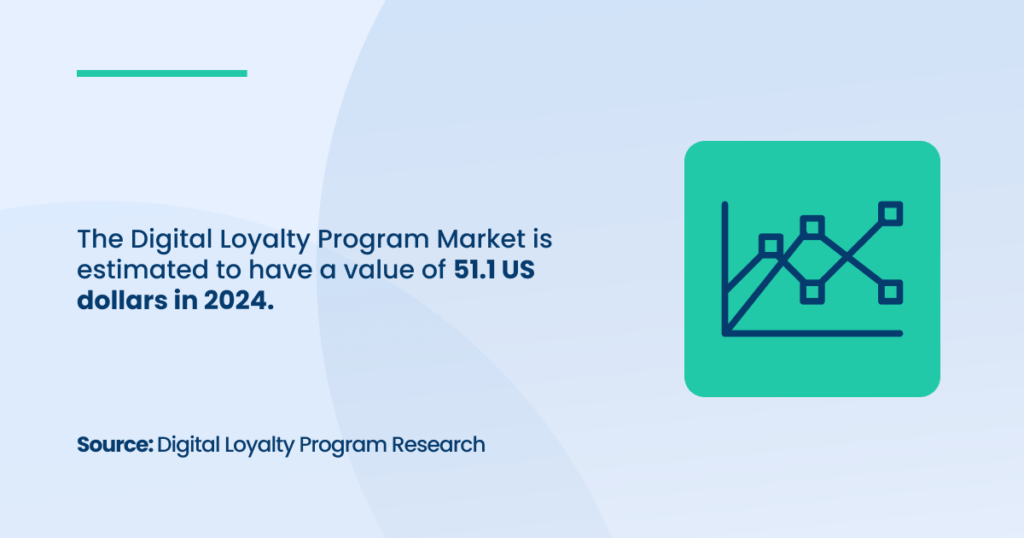
Why Digital Loyalty Programs Matter
- Data-Driven Insights: App-based loyalty programs collect valuable customer data, allowing you to tailor promotions and menu offerings based on purchase history.
- Personalized Experiences: Customers appreciate when their preferences are acknowledged. Digital programs can automatically send personalized rewards, like a free dessert for a birthday or exclusive early access to new dishes.
- Boosted Retention Rates: Research from Harvard Business Review shows that increasing customer retention by just 5% can boost profits by 25-95%.
Implementing a Successful Digital Loyalty Program
- Choose the Right Platform: Opt for a loyalty program app that integrates seamlessly with your current POS system. Ensure it offers easy-to-navigate interfaces for both your team and customers.
- Offer Meaningful Rewards: Points systems, tiered benefits, and exclusive perks keep customers engaged. Go beyond the basic “earn 10 points, get a free coffee” model; offer innovative perks like VIP event invites or special chef’s table experiences.
- Gamify the Experience: Introduce gamified elements where customers can earn bonus points for attending events, sharing on social media, or trying a new dish.
- Analyze and Adjust: Track the performance of your loyalty program to see which rewards drive the most engagement. Use these insights to iterate on your offerings.
CEO Insight: Digital loyalty programs are not just about sales; they’re about creating a dialogue with your customers. Use the data to refine your overall growth marketing approach and foster long-term relationships.
12. SEO for CEOs: Capturing Local Searches with Ease
Imagine being the top restaurant that pops up when someone searches “best restaurant near me.”
Local SEO (Search Engine Optimization) strategies can make this a reality and drive a steady stream of foot traffic to your restaurant.
For CEOs, understanding and investing in local SEO isn’t just an option; it’s a vital growth marketing strategy.
Why Local SEO Matters for Your Business
- Visibility in “Near Me” Searches: Studies show that 46% of all Google searches are looking for local information. If your restaurant isn’t optimized for local search, you’re likely missing out on valuable customer growth.
- Competitive Advantage: Optimizing for local SEO places you ahead of competitors who haven’t embraced these innovative marketing strategies.
- Reputation Building: A strong local presence fosters trust, making your brand the go-to option for diners in your area.
Key Strategies for Effective Local SEO
- Optimize Your Google My Business (GMB) Profile: Ensure your GMB profile is complete, up-to-date, and showcases essential information like hours, address, and photos. This will increase your chances of appearing in local searches and Google Maps results.
- Collect Customer Reviews: Encourage satisfied customers to leave positive reviews. Research suggests that positive reviews can improve your local ranking and influence 88% of consumers who trust online reviews as much as personal recommendations.
- Use Localized Keywords: Incorporate location-specific terms in your website content and meta descriptions, such as “best brunch in [city]” or “organic restaurant near [neighborhood].” This helps search engines understand your relevance to specific local queries.
- Leverage Location-Based Content: Write blog posts about local food trends, upcoming community events, or even collaborations with local businesses. This not only engages your community but also boosts your SEO.
CEO Action Plan: Collaborate with a growth marketing agency that specializes in local SEO and ask key onboarding questions to ensure they align with your vision. This partnership can streamline the optimization process and keep you informed about the latest trends in restaurant marketing.
13. High-Impact Visuals: Why Professional Photos and Videos Matter
They say you eat with your eyes first. In the digital world, professional visuals can be the deciding factor between a customer choosing your restaurant or scrolling past to the next option.
Investing in high-quality photos and videos is no longer just nice to have—it’s essential.
Why Professional Visuals Are Key
- Boosts Engagement: High-quality visuals are proven to increase user engagement. Research shows that articles with images get 94% more views than those without.
- Reflects Your Brand’s Quality: If your restaurant is known for gourmet dishes and an upscale ambiance, poor-quality images could send the wrong message. Professional visuals reinforce the high standards you’ve set.
- SEO Benefits: Well-optimized photos and videos can improve your SEO. Including alt text with localized keywords and captions can help your images appear in search results, adding to your overall online presence.
CEO Tip: Professional visuals are part of a successful growth marketing strategy. Ensure your marketing agency includes high-impact media as part of your onboarding process. This step solidifies your brand’s image and consistency across all marketing channels.
14. Engage, Don’t Just Post: The Art of Interactive Social Media
Posting is easy; engaging is an art.
Interactive social media strategies can transform passive followers into active participants and loyal customers.
Source: Smart insights
CEOs should view social media as more than just a marketing tool—it’s a community builder.
Why Engagement Beats Simple Posting
- Builds Relationships: People want to connect with brands that feel human. Interactive posts show your restaurant’s personality and invite conversations.
- Algorithm Benefits: Social media algorithms prioritize posts that receive interactions like comments, shares, and saves. This means more visibility for your brand.
- Fosters Customer Loyalty: Engaging content encourages followers to come back for more, building a community that’s invested in your success.
Ways to Engage Your Audience
- Run Polls and Q&A Sessions: Ask followers questions like “Which new dessert should we add to the menu?” or host a “Get to Know the Chef” live Q&A. It’s an easy way to gather feedback while making followers feel included.
- Host Contests: “Share your favorite dish at [Your Restaurant Name] and tag us for a chance to win a free dinner.” This generates user-generated content and expands your reach.
- Share User-Generated Content (UGC): When customers tag you in their posts, share their content (with permission). This not only shows appreciation but also builds trust and authenticity.
CEO Strategy: If you’re working with a growth marketing agency, ensure they have a clear experimentation roadmap for testing different interactive social media strategies to find what resonates best with your audience.
15. Seasonal Specials with a Twist: Keeping Your Menu Fresh
Stagnant menus can lead to stagnant sales.
Introducing seasonal specials keeps your restaurant dynamic and encourages repeat visits. It’s also an excellent way to experiment with new flavors and ideas that align with current restaurant marketing trends.
The Impact of Seasonal Specials
- Creates Excitement: Limited-time offers create a sense of urgency, motivating customers to visit before the special ends.
- Showcases Fresh Ingredients: Highlighting seasonal ingredients positions your restaurant as committed to quality and sustainability. Diners appreciate knowing they’re eating dishes made with peak-season produce.
- Encourages Repeat Visits: Regular customers always look for something new. Seasonal specials give them a reason to keep coming back.
Creative Ideas for Seasonal Specials
- Seasonal Themes: Align your dishes with holidays or local events. For example, a summer menu featuring light, refreshing dishes or a winter menu with hearty, comforting options.
- Collaborations: Partner with local farms or suppliers for a “Farmers’ Market Special.” This promotes your use of fresh, local ingredients and supports community businesses.
- Flavor Twists: Introduce a popular dish with a seasonal twist, such as pumpkin-spiced desserts in the fall or berry-infused cocktails in the summer.
CEO Insight: Seasonal menus are a strategic way to integrate innovation into your restaurant marketing. Regularly refreshing your offerings shows that your restaurant evolves with trends and meets customer expectations, fostering lasting loyalty.
Final Thoughts: Are you Ready to Spice Up Your Restaurant Marketing?
Food is more than sustenance. It’s an experience.
These 15 marketing ideas and trends are your secret ingredients to creating a memorable dining experience that keeps customers coming back for seconds.
By embracing technology, fostering community, and prioritizing quality, you can elevate your restaurant from ordinary to extraordinary.
[A] Growth Agency will gladly be part of your journey. Our marketers are specialized in turning entrepreneurial dreams into reality with effective, tailored growth strategies.
At heart, we’re a team of data-driven growth marketers focused on delivering scalable results!
Growth is our driving force.
Let’s Get Started Together
